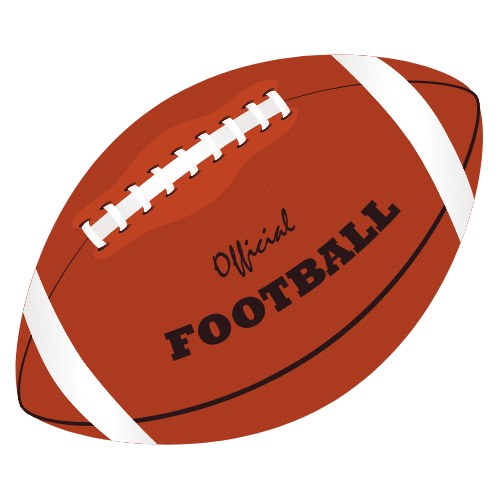Rule 3 - Periods, Time Factors and Substitutions
SECTION 1. Start of Each Period
Article 1 - First and Third Periods
a. Prior to the game, during warm-ups, teams must remain in an agreed separate half of the field, normally the half up to the line five yards from midfield to their left, looking from their team area towards the field.
b. When any squad member enters the playing enclosure prior to the officials escorting the captains out for the coin toss, the head coach or an assistant coach from that team must be present on the field.
c. When squad members are present within the playing enclosure subsequent to the officials’ jurisdiction, they must be wearing their jerseys or have their numerals readily visible. Any player without their numeral readily visible must leave the playing enclosure.
d. During the coin toss, each team shall remain in the team area. The coin toss begins when the field captains leave the sidelines and ends when the captains return to the sidelines.
PENALTY − [d] Five yards from the succeeding spot [S19: IPR].
e. The winner of the toss shall choose one of the following options:
1. To designate which team shall kick off.
2. To designate which goal line his team shall defend.
3. To defer his selection to the second half.
f. The opponent shall then choose option 1 or 2 above, as available.
g. If the winner of the toss chooses option 3 above, then after the opponent’s choice the winner selects the available option (1 or 2 above).
h. For the second half, the loser of the toss, or the winner who chooses option 3 above, shall choose option 1 or 2 above. The opponent then chooses the remaining available option.
Article 2 - Second and Fourth Periods
Between the first and second periods and also between the third and fourth periods, the teams shall defend opposite goal lines.
a. The ball shall be relocated at a spot corresponding exactly, in relation to goal lines and sidelines, to its location at the end of the preceding period.
b. Possession of the ball, the number of the down and the distance to be gained shall remain unchanged.
Article 3 - Extra Periods
The tiebreaker system will be used when a game is tied after four periods. (Exception: Competitions may adopt regulations to forgo the tiebreaker system if the scores are tied at the end of a regular season game. In that event, the game shall be terminated and the result shall stand as a tie.) IFAF football-playing rules apply, with the following exceptions:
a. Immediately after the conclusion of the fourth quarter, officials will instruct both teams to retire to their respective team areas. The officials will assemble at the midfield line and review the tiebreaker procedures.
b. The officials will escort the captains (Rule 3-1-1) to the centre of the field for the coin toss. The referee shall toss a coin at midfield in the presence of not more than four field captains from each team and another game official, first designating the field captain of the visiting team to call the coin toss. The winner of the toss may not defer the choice and must choose one of the following options:
1. Offense or defense, with the offense at the opponent’s 25-yard line to start the first possession series.
2. Which end of the field shall be used for both possession series of that overtime period.
c. The loser of the toss shall exercise the remaining option for the first extra period and shall have the first choice of the two options for subsequent even-numbered extra periods.
d. Definition. An extra period shall consist of two possession series with each team putting the ball in play by a snap on or between the hash marks on the designated 25-yard line (unless relocated by penalty); this becomes the opponent’s 25-yard line. The snap shall be from midway between the hash marks, unless the offensive team selects a different position on or between the hash marks before the ready-for-play signal. After the ready- for-play signal, the ball may be relocated only after a charged team timeout, unless preceded by a Team A foul or offsetting fouls.
e. Possession series. Each team retains the ball during a possession series until it scores or fails to make a first down. The ball remains alive after a change of team possession until it is declared dead. However, Team A may not have a first down if it regains possession after a change of team possession (A.R. 3-1-3:I-IX). Beginning with the third extra period, a team’s possession series will be one play for a two-point try from the three-yard line, unless relocated by penalty.
Team A and B designations are the same as defined in Rule 2-27-1.
f. Scoring. The team scoring the greater number of points during the regulation and extra periods shall be declared the winner. There shall be an equal number of possession series, as described in (e) above, in each extra period, unless Team B scores other than on the try. Beginning with the third second period, teams scoring a touchdown must attempt a two-point try. Although not illegal, a one-point try attempt by Team A will not result in a score (A.R. 3-1-3:X).
g. Fouls after a change of team possession are treated specially (Rule 10-2-7). (A.R. 3-1-3:XI-XIV)
h. Timeouts. Each team shall be allowed one timeout for each extra period (Rule 3-3-7). Timeouts not used during the regulation periods may not be carried over into the extra period(s). Unused extra period timeouts may not be carried over to other extra periods. Timeouts between periods shall be charged to the succeeding period.
Radio and television timeouts are permitted only between extra periods (first and second, second and third, etc.). Charged team timeouts may not be extended for radio and television purposes. The extra period(s) begins when the ball is first snapped.



